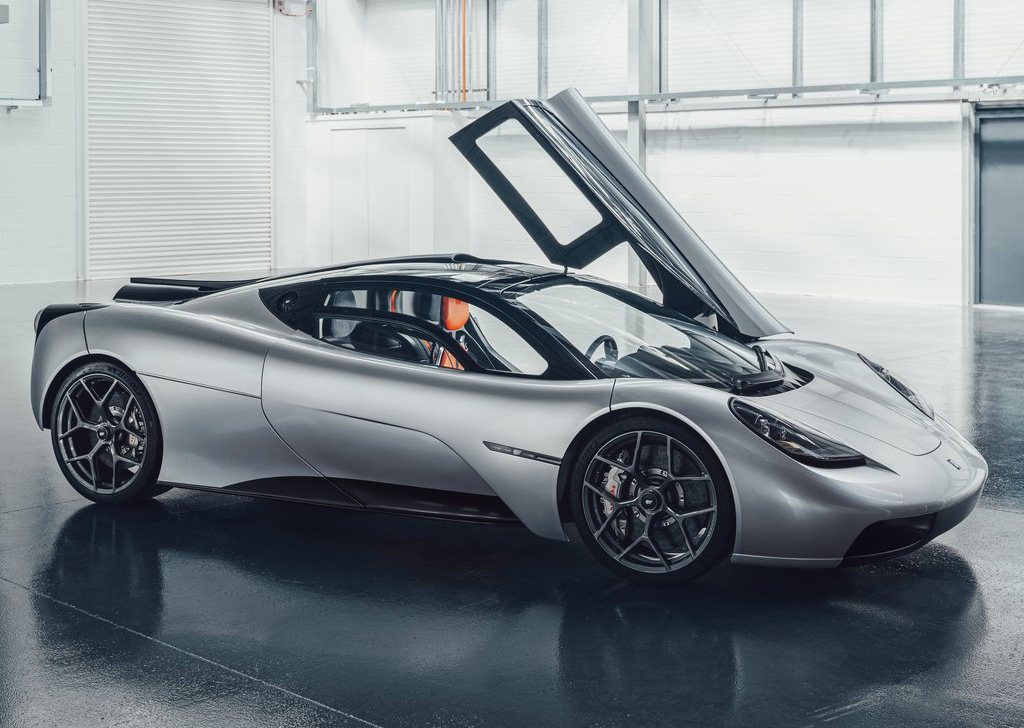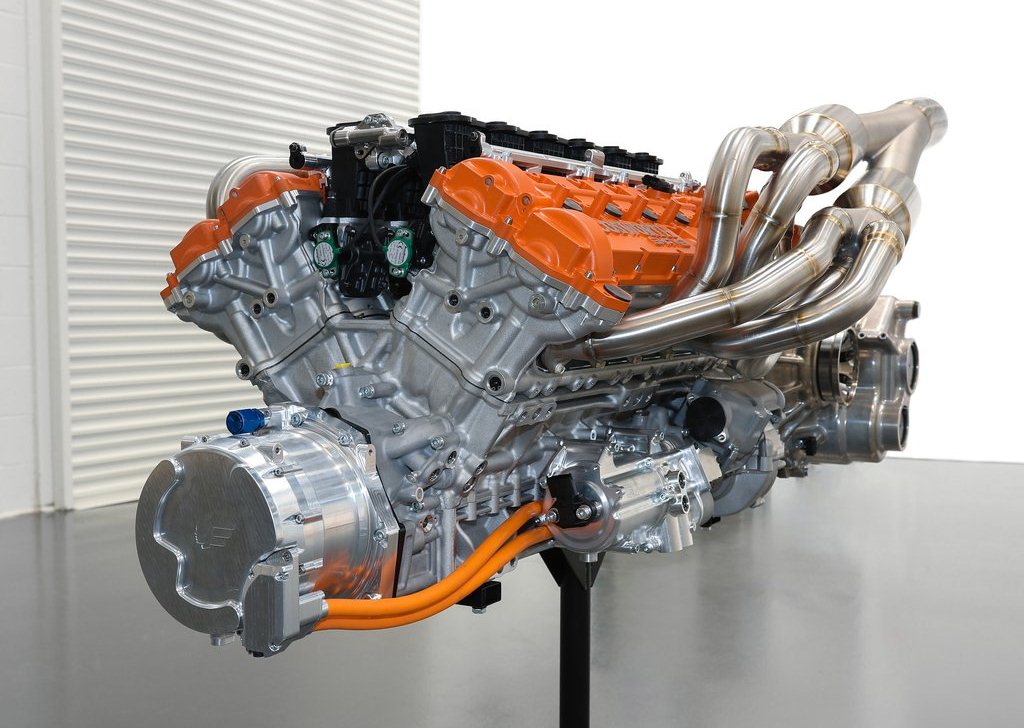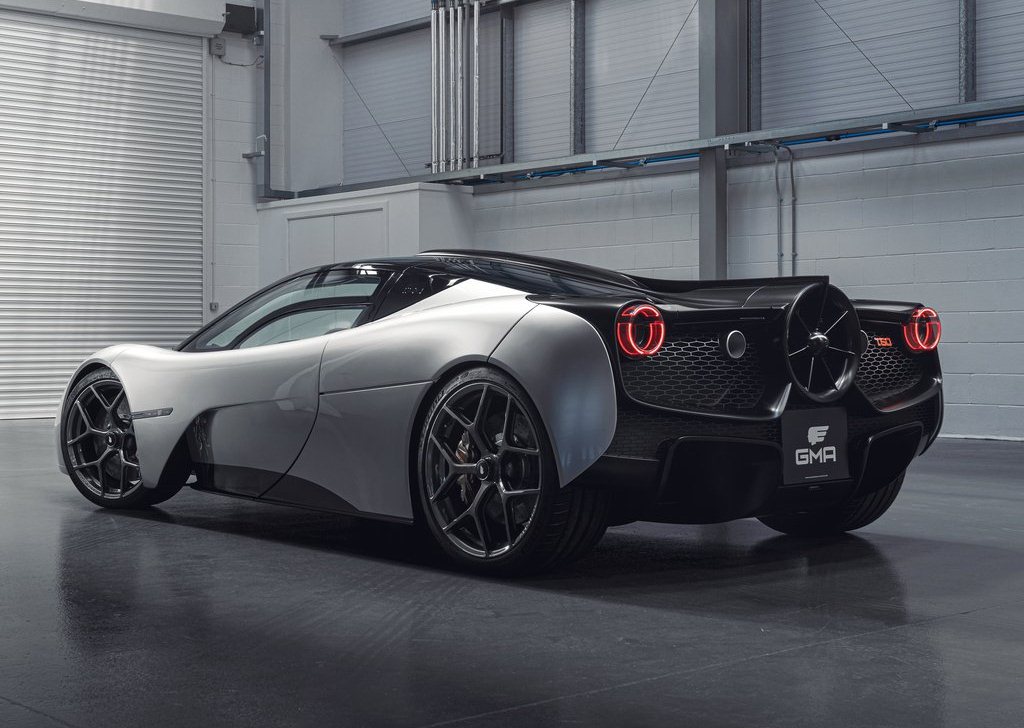Gordon Murray Automotive has unveiled its T.50 supercar in full for the first time, showing the finished exterior and interior design and confirming its ground-breaking technical specifications. The T.50 has been engineered to be the purest, lightest, most driver-centric supercar ever.
Improving on his acclaimed McLaren F1 "in every conceivable way", Professor Gordon Murray CBE is leading the team that will begin building customer versions of the 986kg supercar in January 2022. Justifying its £2.36m (before taxes) price tag, the T.50 promises to deliver an unsurpassed driving experience. It is powered by a 100% bespoke 3.9-litre, 663PS V12 engine that revs to a record-breaking 12,100rpm, and features the most advanced and effective aerodynamics ever seen on a road car - aided by a 400mm rear-mounted fan.
The global premiere is the first time the clean lines of the exterior and the driver-focused interior have been seen. From his first ballpoint sketches, to every engineering and design detail, Murray has led the Gordon Murray Automotive team and briefed and overseen suppliers to drive the project forward at an unrelenting pace. Murray's design for T.50 was the 50th in a prestigious line of race and road cars he's penned over his illustrious 50-year career - both reasons combining to name the car T.50.
The T.50 mission - Driving perfection
At the heart of T.50 ethos is the ultimate, sensory-rich driving experience, which all starts with the central driving position. The 'jet-fighter' style seating position affords an unhindered view out of the cabin, offering the type of pure driving experience usually associated with a single-seater race car layout.
Murray insists that the engine contributes to at least 50% of a great driving experience. With this in mind, Murray set out to create the greatest ever V12. The bespoke Cosworth GMA unit hits the mark as the world's highest revving, fastest responding, most power dense, and lightest road-going V12. In terms of aural enjoyment, the T.50 raucous 12,100rpm redline will certainly deliver on wow-factor. The car also features Direct Path Induction Sound - a system pioneered on the McLaren F1 and refined on the T.50 to channel the sound of the throttle-induced induction growl into the cabin.
A cold-air ram induction intake sits immediately above the driver's head, and carefully crafted carbon fibre panels in the roof act as a loudspeaker, amplifying engine sound within the cabin. The system is actuated by throttle angle and not revs, meaning the T.50 is quiet and refined on part throttle, growing louder as the throttle opens.
Chassis and body - carbon fibre throughout achieves rigidity and lightness
The chassis and body of the T.50 are entirely constructed from high-grade carbon fibre. Creating inherent stiffness and torsional rigidity, the carbon fibre plays an important role in making T.50 the world's lightest supercar.
Murray: "With the design of our T.50 supercar, we are taking the same focused approach that was applied to the design of the McLaren F1. Thanks to modern materials and 30 years of development, we have been able to deliver a far better all-round car in the T.50, while setting its weight at just 986kg, a full 150kg lighter than the F1."
At the core of the T.50 is a lightweight carbon fibre monocoque. It has been constructed by UK-based company Formaplex and features novel, cutting-edge part-bonded carbon fibre an aluminium honeycomb core. This construction method gives the T.50 exceptional structural rigidity, which benefits handling, agility and ride comfort.
Aerodynamics - the most advanced aerodynamics of any road car
The T.50 takes road-car aerodynamics to entirely new levels, with Murray rewriting the rule book to significantly enhance the supercar's ground-effect capabilities. To achieve unmatched aerodynamic performance, the car's rear-mounted 400mm fan rapidly accelerates air passing under the car, forcing it through active boundary-layer control ducts that form part of the rear diffuser.
Through the application of two automatic and four driver-selected aero modes, the T.50 is capable of increasing downforce by 50%; reducing drag by 12.5%; adding around 50PS to the car's output in combination with ram-air induction; and cutting braking distance by 10m from 150mph.
The fan and its associated ducting system improve on conventional ground-effect systems by actively managing both underbody and overbody airflow. This boundary layer control ensures the most effective interaction of airflow on top of, and below the car, balancing drag and downforce at all speeds.
Design - purity enabled through engineering
Murray: "Next-level aerodynamics allow us to avoid the current supercar trend for exaggerated wings, vents and ducts. I was determined to create a clean and pure shape that would remain timeless, ensuring the T.50 will still look fresh in 30 years."
The most dominant characteristics of the T.50 design are purity and balance. Enabled by the most advanced and effective aerodynamics ever seen on a road car, the exterior of the T.50 indulges Murray's preference for simple, timeless lines and clean surfaces. The design does not rely on wings, vents, or ducts to emphasise its performance capabilities. Instead the eye is drawn to the compact, balanced proportions and driver-centric symmetry.
Stylistically, the T.50 is far from drama-free. The remotely-released dihedral doors rise up and forwards creating a striking visual impact, as well as easing ingress and egress even in tight parking spaces. These doors are joined by a pair of glass-topped gullwing rear openings that hinge along the spine of the T.50 to reveal the V12 powertrain - crucially free form covers - making it easy to view and to access for maintenance.
Engine - The greatest road-car V12 ever made
Murray: "To be truly remarkable, an engine needs to have the right characteristics: highly-responsive, an amazing sound, engaging torque delivery, free-revving, and it has to be naturally aspirated. For all those reasons, the engine in the T.50 was never going to be anything other than a V12."
The 3.9-litre T.50 engine delivers maximum power (663PS) at 11,500rpm, on its way to a 12,100rpm redline. The Cosworth GMA V12 not only promises screaming high-end power, it is also extremely tractable for everyday driving. The maximum torque figure of 467Nm is produced at 9,000rpm, while the pick-up is a record-breaking 28,400 revs per second.
The T.50 has the highest power density (166PS-per-litre) of any road-going V12. It is also the lightest ever made thanks to a combination of exceptional design and lightweight materials (aluminium, steel and titanium) resulting in a total engine weight of just 178kg.
Transmission - bespoke and lightweight - the ultimate gearshift
Murray: "The car's six-speed H-pattern manual transmission is a tribute to Xtrac's skill, continuing our focus on driver engagement. The gearchange motion and weighting was honed meticulously until we achieved the perfect end result. The outcome is a narrow cross gate and a short throw. It delivers slick, crisp gearchanges - truly a joy for the driving enthusiast."
Being totally bespoke, it was possible to optimise every component of the gearbox for weight. Remarkably, the Xtrac team created a super-strong but extremely light aluminium housing that was cast at just 2.4mm thickness - resulting in a gearbox that not only met strict packaging requirements within the car, but also weighed in at just 80.5kg.
The transmission features five close ratios, geared for acceleration, with a longer sixth ratio for cruising. Reverse is selected having first flicked the red 'lockout' switch set next to the titanium gear lever.
Vehicle Dynamics - a focus on lightweight
Murray: "Weighing just 986kg, the T.50 undercuts the average supercar weight by almost a third. A heavy car can never deliver the dynamic attributes of a lighter car - even if it has the same power to weight ratio. While it is possible to disguise a heavy car's dynamic capabilities with complex active suspension and sophisticated electronics, the agility, responsiveness and reward of a lightweight vehicle simply cannot be matched."
In designing the T.50, Murray applied one of his core supercar philosophies, reversing the traditional focus on power-to-weight, to instead consider the vehicle's 'weight-to-power' ratio. In the T.50, every 100PS has to propel just 150kg of car, whereas for the typical supercar (1,436kg with 693PS) the weight it has to shift is 40% higher, at 207kg. It is this weight-to-power calculation that drives the development of the T.50, with every component designed and engineered to achieve the lowest possible weight.
Powered by its 663PS V12 engine, the lightweight T.50 sets a challenging benchmark for rival supercars. To match the T.50's 672PS/tonne, the typical 1,436kg supercar would need almost 300PS more power. But the 963PS required to match the T.50 on paper would add cost, complexity, and require larger, heavier components to handle the extra power.
Interior - a jet fighter cockpit for three
From the outside looking in, the T.50 appears to be a single seater racing car. With intentional focus on the driver, Murray specified the driver's seat to stand out in a vivid colour, while the two passenger seats that flank it are trimmed to blend in with the rear bulkhead.
As the dihedral doors lift, they present a wide opening that grants easy access to the cabin for driver and passengers. The design of the carbon fibre monocoque moves the need for torsion beams from the centre of the passenger compartment to the outside of the chassis, meaning the floor is free from obstruction.
Each customer will have a personalised seat fitting during the specification process, at the same time adjusting the steering wheel height and reach, and fine tuning the set-up of the pedal box.
Everyday usability - the ultimate supercar that's easy to live with
The Gordon Murray Automotive team evaluated ease of access to the T.50 at length. More than 40 people of all ages and sizes took part in an assessment of a range of different seating permutations. The car's dihedral doors were chosen to enhance the ease of getting in and out, while the sill of the carbon tub sits low to the ground and the flat cabin floor is free from obstructions across the full width of the car.
Once inside, visibility out is excellent, in no small part due to the central driving position. The car's compact proportions mean that its footprint is comparable to that of an average C-segment hatchback, making it easy to park and place on narrow roads or in urban environments.
Technology - all the driver essentials, no driver distractions
Every display in the T.50 is simple. White graphics on a plain black background ensure ease of use and quick recognition for the driver with minimal distraction. Even the rear-view displays are optimised for the driver, offering a better field of vision than mirrors and weighing significantly less.
Delivering a premium audio experience was a key element of the T.50 brief. Here Murray stuck to his key principals for the car; lightweight, highest-quality and British. Again, bucking industry trends, Murray enlisted high-end audio specialists Arcam to create a 700W nominal 10-speaker 100% bespoke sound system for the T.50.






















0 Comments